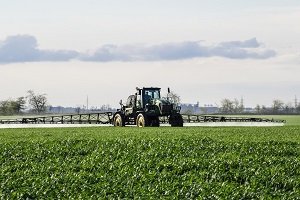
Environmental Insurance for Fertilizer Applicators
Fertilizer application can have significant benefits to the agriculture industry, but may also create complicated and harmful impacts on the environment. The application of nutrients needed for plant growth has caused a wide range of water and air pollution that can be damaging to human & animal health, cause algal blooms, and threaten delicate ecosystems.
Farmers apply nutrients on their fields in the form of chemical fertilizers and animal manure, which provide crops with the nitrogen and phosphorus necessary to grow. However, when these components are not fully used by the growing plants, are washed away during rain events, or are applied in the wrong amounts/at the wrong time, they can be lost from the fields and negatively impact soil, nearby water bodies, and well systems. Fertilized soils are also vulnerable to nutrient losses in the air. Nitrogen can released from farm fields in the form of nitrogen-based compounds, like ammonia and nitrogen oxides. Ammonia can be harmful to aquatic life if large amounts accumulate in the atmosphere and nitrous oxide is a potent greenhouse gas.
Environmental exposures associated with fertilizer applicators
- The mis-application or over-application of fertilizers.
- Over the road spills of solid or liquid fertilizers.
- Storage of chemicals/fertilizers/equipment, causing an on-site pollution condition that must be cleaned up.
- Rain events leading to fertilizer runoff into water bodies, harming wildlife/fish and other important ecosystems.
- Odors from fertilizer may cause air quality issues.
Environmental insurance for fertilizer applicators
The basic insurance product that can respond to the environmental exposures of fertilizer applicators is a Contractors Pollution Liability (CPL) policy. This is a product that will respond to third party claims against the applicators for pollution conditions that they create or exacerbate. These claims may be for bodily injury as a result of fertilizer application activities, property damage as a result of application activities, or the ensuing cleanup costs related to these activities.
Another product that pesticide applicators should consider is an Environmental Impairment Liability (EIL) policy, also known as Premises Pollution Liability or Pollution Legal Liability Policy (PLL). This product provides coverage for the fertilizer company for their owned or leased locations. This includes coverage for third party bodily injury, third party property damage, and first as well as third party cleanup costs in the event the fertilizer applicator creates a pollution condition on or off site. This is often used for locations where fertilizer companies might store their chemicals or equipment or for the laboratories that they might use.
Both of these policies can be endorsed as follows:
Transportation Pollution Liability Coverage – this is a coverage enhancement that is designed to respond to spills that occur during the transportation of fertilizers or other chemicals while they are being taken from the distributor warehouse, for example, to a jobsite or vice versa. This coverage typically responds to spills during loading/unloading activities at the jobsite or at the applicator’s facility also.
Non-owned Disposal Site Coverage – this is a coverage enhancement that is designed to respond to claims against the fertilizer company for the waste they dispose of at non-owned disposal sites. These disposal sites can be brought into claims for bodily injury, property damage, or cleanup costs by third parties that have been adversely affected by the disposal site. What usually happens is the disposal site or environmental regulators will make a claim for cleanup costs, bodily injury, or property damage against anyone that ever took any materials or waste to the disposal site.
For more information or to discuss a fertilizer applicator account, contact us.
Other resources:
Pollution Coverage for Biosolid Applicators
Protecting Farms and Agribusiness Facilities: Site Pollution Insurance
Information for this overview was obtained from the following sources:
https://www.epa.gov/nutrientpollution/sources-and-solutions-agriculture
Type: Blog
Topic: Fertilizer